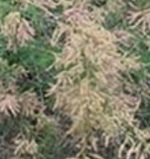 Native to Eastern Europe and parts of Asia, tamarisk is a deciduous shrub or small tree growing 6-15’ tall with a deep root system, smooth reddish brown bark and small light gray-green leaves that are sessile and scale-like. The pink flowers have five petals and are carried in plume-like racemes ½-2 ¾” long in summer, giving way to dry capsules filled with an abundance of seeds. Plants are drought and salt tolerant and are a good choice for seaside gardens if used with care. Tamarisk has invaded wetlands and waste areas from Virginia south to Georgia, west to California and the Pacific Northwest forming impenetrable thickets that destroy native plant communities. The genus name, Tamarix, is the Latin name for the plant. The specific epithet, ramosissima, is from the Latin word ramus meaning branch, and means very branched.
Native to Eastern Europe and parts of Asia, tamarisk is a deciduous shrub or small tree growing 6-15’ tall with a deep root system, smooth reddish brown bark and small light gray-green leaves that are sessile and scale-like. The pink flowers have five petals and are carried in plume-like racemes ½-2 ¾” long in summer, giving way to dry capsules filled with an abundance of seeds. Plants are drought and salt tolerant and are a good choice for seaside gardens if used with care. Tamarisk has invaded wetlands and waste areas from Virginia south to Georgia, west to California and the Pacific Northwest forming impenetrable thickets that destroy native plant communities. The genus name, Tamarix, is the Latin name for the plant. The specific epithet, ramosissima, is from the Latin word ramus meaning branch, and means very branched.
Type: Deciduous shrub or small tree
Outstanding Feature: Flowers
Form: Rounded
Growth Rate: Rapid
Bloom: Racemes ½-2 ¾” long of pink five petaled flowers in summer
Size: 6-15’ H x 8-13’ W
Light: Full sun
Soil: Average, dry to medium moist, well-drained
Hardiness: Zones 3-8
Care: Prune in late winter or early spring to maintain form and promote good growth; may be pruned back hard.
Pests and Diseases: None of significance
Propagation: Seed, cuttings
Comments: Salt and drought tolerant; invasive in warm climates (USDA Hardiness Zones 8-10)